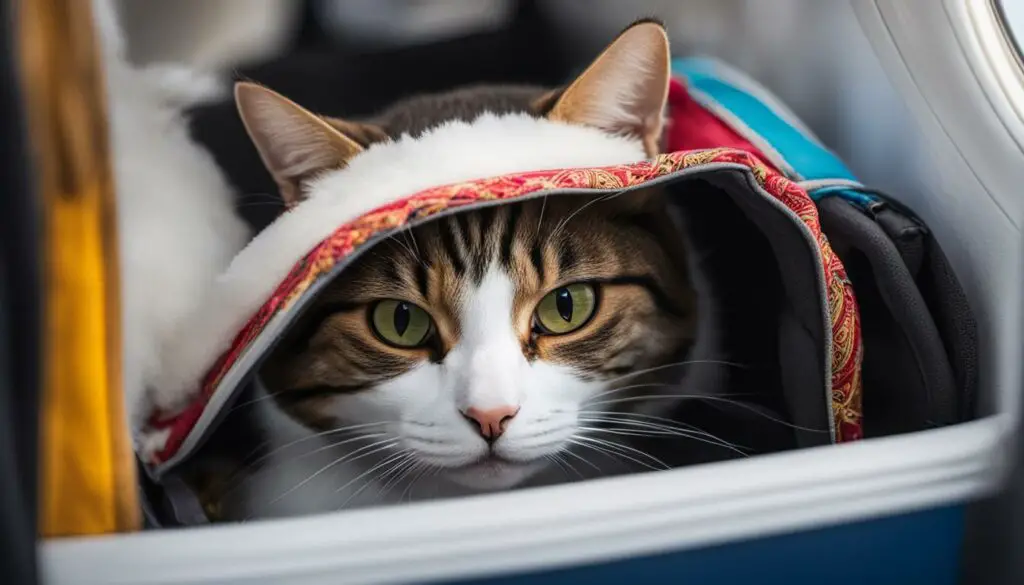Flying with cats in the cabin can be a stressful experience for both you and your furry friend. However, with proper preparation and planning, you can make the journey easier and more comfortable. In this comprehensive guide, I will provide valuable tips and tricks to ensure a stress-free experience when flying with cats in the cabin.
Key Takeaways:
- Ensure your cat is healthy enough to travel and meets all necessary requirements.
- Select a cat carrier that meets airline regulations and acclimate your cat to spending time in it.
- Consult with a veterinarian and obtain a health certificate before flying with your cat.
- Familiarize yourself with airline rules and regulations regarding pet carriers.
- Expose your cat to airport environments and airplane sounds to minimize anxiety.
Flying with Cats in Cabin Tips [Before Flight]
Preparing for a smooth and stress-free journey when flying with cats in the cabin requires careful planning and preparation. Before booking your flight, it’s essential to ensure that your cat is healthy and able to travel. Consulting with your veterinarian is crucial to determine if your cat meets all the necessary requirements for air travel. This includes ensuring that your furry friend is in good health and up to date on vaccinations.
Another important consideration is selecting the right cat carrier that complies with airline regulations. Each airline may have specific size and material requirements for pet carriers. Gradually acclimating your cat to spending time in their carrier is also necessary to help them feel more comfortable during the flight. Introduce the carrier gradually and create a positive association by providing treats, toys, and familiar bedding.
Being familiar with the signs of distress in cats is essential. Cats may exhibit signs of distress such as excessive meowing, panting, drooling, and restlessness. It’s important to be aware of these signs and understand how to provide comfort and reassurance to your furry friend. Additionally, make sure to gather all the necessary paperwork and supplies before your trip, including health certificates, vaccination records, and any required documentation from the airline.
By following these tips and ensuring careful preparation, you can create a comfortable and stress-free experience for both you and your feline companion when flying in the cabin.
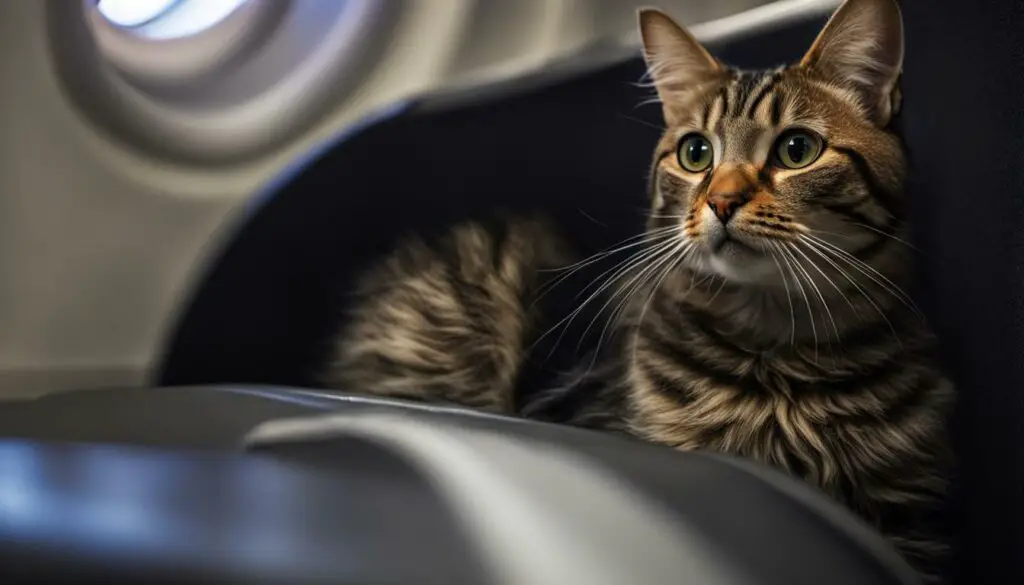
Is Your Cat Healthy Enough to Travel?
Before flying with cats in the cabin, it is crucial to ensure that your furry friend is in good health and fit for travel. Cats that are too young, too old, in heat, pregnant, have chronic illnesses, or have poor temperaments may not be suitable for air travel. To ensure the well-being of your cat during the journey, it is recommended to have them checked by a veterinarian and obtain a health certificate.
A veterinarian health certificate serves as proof that your cat is healthy enough to travel. Airlines often require this certificate to ensure the safety and health of all pets on board. The certificate should include information such as the cat’s name, age, breed, vaccination history, and a statement from the veterinarian confirming their fitness for travel. It is important to check with your airline for specific requirements regarding the health certificate.
Consulting with a veterinarian and obtaining a health certificate not only ensures the well-being of your cat but also provides peace of mind for both you and the airline. By prioritizing your cat’s health and following the necessary precautions, you can embark on a safe and stress-free journey with your furry companion.
| Benefits of Obtaining a Health Certificate | Considerations for Air Travel |
|---|---|
| – Ensures your cat is healthy and fit for travel | – Consult with your veterinarian to determine if your cat is suitable for air travel |
| – Provides proof of immunizations and vaccinations | – Avoid air travel if your cat is very young, old, in heat, pregnant, or has chronic illnesses |
| – Meets airline requirements for pet travel | – Obtain a health certificate from your veterinarian certifying your cat’s fitness for travel |
| – Ensures the safety and well-being of your cat during the journey | – Check with your airline for specific health certificate requirements |
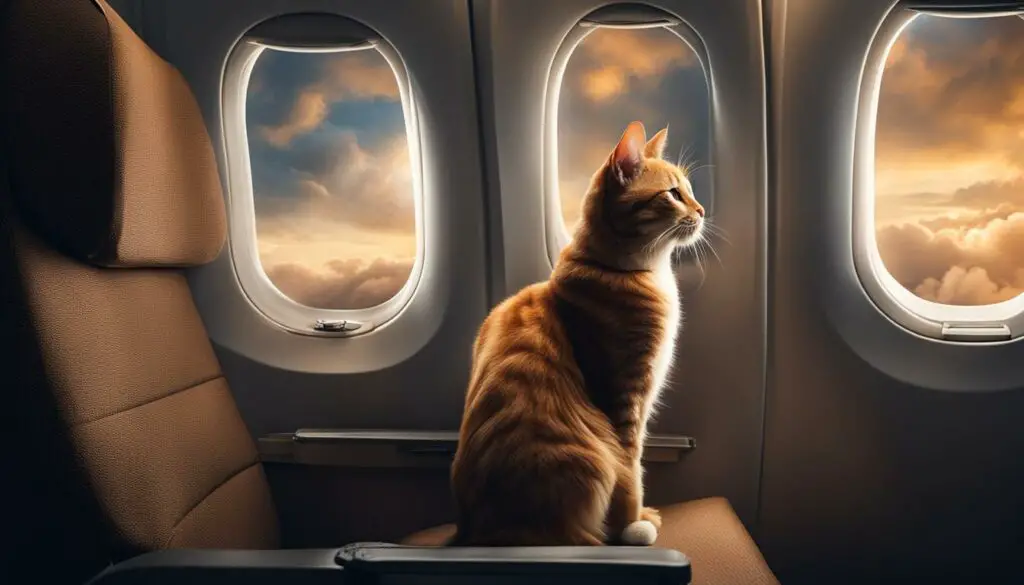
Flying with Cats in Cabin Tips [Selecting the Right Cat Carrier]
When it comes to flying with cats in the cabin, selecting the right cat carrier is crucial. Airlines have strict regulations regarding the type and size of carriers allowed on board. It’s important to choose a carrier that not only meets these requirements but also provides a comfortable and secure space for your furry friend.
Soft-sided carriers are generally recommended for cabin travel as they are more flexible and can easily fit under the seat in front of you. Ensure that the carrier is well-ventilated and has secure closures to prevent any escapes during the flight. Additionally, make sure the carrier is large enough for your cat to stand, turn around, and lie down comfortably.
Before your trip, it’s a good idea to get your cat accustomed to the carrier. Gradually introduce them to the carrier by placing treats, toys, and familiar bedding inside. This will help create a positive association and reduce any anxiety they may have while inside the carrier.
Tips for Selecting the Right Cat Carrier:
- Check the airline’s regulations for carrier size and type
- Choose a soft-sided carrier for flexibility and easy storage
- Ensure the carrier is well-ventilated and secure
- Make sure the carrier is large enough for your cat to move comfortably
- Gradually acclimate your cat to the carrier before the trip
By selecting the right cat carrier and familiarizing your feline friend with it beforehand, you can help ensure a comfortable and stress-free journey for both of you.
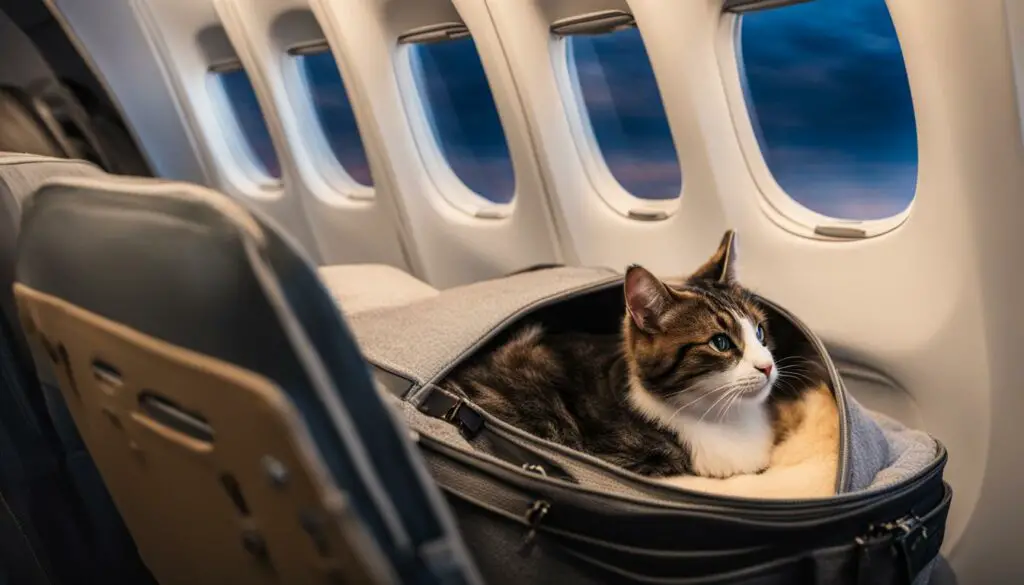
Flying with Cats in Cabin: Getting Your Cat Used to Confined Spaces
When it comes to flying with cats in the cabin, getting your feline companion used to confined spaces is crucial for a stress-free journey. Cats need time to acclimate to spending extended periods in their carriers, ensuring they feel calm and comfortable during the flight. Let’s explore some tips to help your cat adjust to confined spaces and make the travel experience smoother.
Gradual Introduction and Positive Association
Start the acclimation process well in advance of your trip by gradually introducing your cat to the carrier. Place the carrier in a familiar and comfortable space, leaving the door open and enticing them with treats, toys, or a familiar blanket. Allow your cat to explore and spend time in the carrier, making it a positive and comforting environment.
Provide praise and rewards when your cat willingly enters the carrier, reinforcing positive associations. Gradually increase the time your cat spends in the carrier, starting with short periods and gradually building up to longer durations. This progressive introduction helps your cat become accustomed to the confined space and reduces anxiety during the flight.
Practice Runs and Short Outings
In addition to gradually introducing your cat to the carrier at home, consider practicing short outings to familiarize them with different environments. Take your cat on car rides in the carrier or visit pet-friendly places to expose them to new sights and sounds. These outings help your cat adjust to the carrier in different contexts, preparing them for the airport and the flight itself.
During these practice runs, ensure the carrier is secure and comfortable, and always prioritize your cat’s safety. Use a sturdy carrier that provides ample space for your cat to move and turn around. Soft-sided carriers are often preferred for their flexibility and easy storage under the seat.
Summary
Getting your cat used to confined spaces is an essential step when flying with cats in the cabin. Gradual introduction, positive association, practice runs, and short outings can help your cat feel more comfortable and less stressed during the actual flight. Remember to prioritize your cat’s well-being by choosing a carrier that meets airline regulations and providing a secure and comforting environment. By following these tips, you can ensure a smoother travel experience for both you and your beloved feline friend.

Familiarize Your Cat with Airports and Airplane Sounds
If you have the opportunity, it’s beneficial to expose your cat to the sights, sounds, and smells of an airport before your flight. Taking them for a visit can help reduce their anxiety and make the actual travel day less overwhelming. By familiarizing your cat with the airport environment, you can help them feel more comfortable and relaxed during the journey. Additionally, if visiting an airport is not feasible, you can play recordings of airplane sounds to familiarize your cat with the noise.
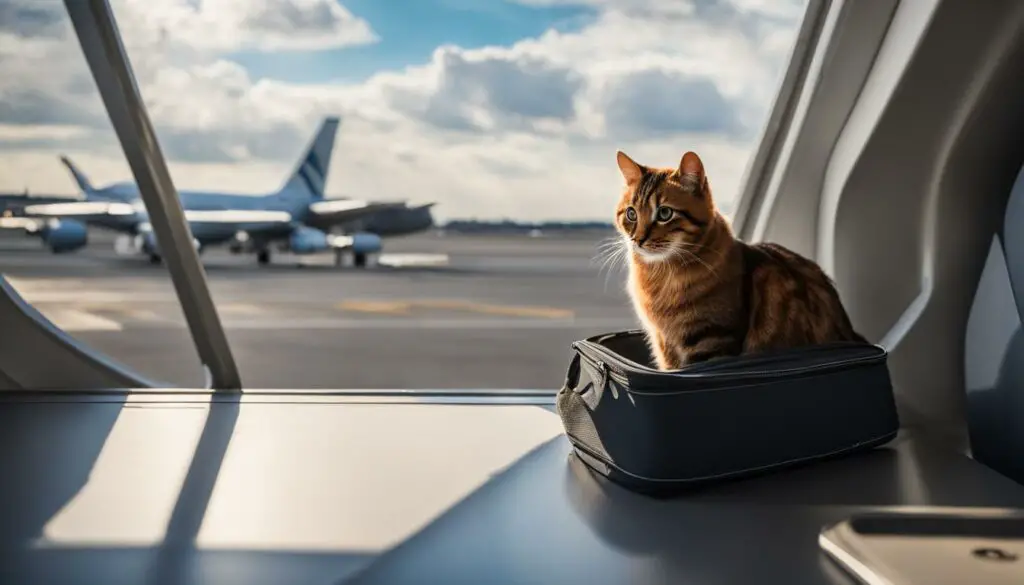
Familiarity with airport environments and airplane sounds can go a long way in easing your cat’s nerves. The hustle and bustle of an airport can be overwhelming for cats, so the more exposure they have, the better prepared they will be. Taking your cat for a visit allows them to become familiar with the sights and sounds they will encounter on their travel day, reducing stress and anxiety.
By gradually introducing your cat to the experience, you can help them adjust and feel more at ease. This exposure can help reduce their anxiety during the actual flight, making the journey more comfortable for both you and your furry friend.
Flying with Cats in Cabin: Limiting Food and Water Before the Flight
When flying with cats in the cabin, it is important to consider food and water restrictions before the flight. Limiting your cat’s access to food and water can help minimize the chances of them needing to use the bathroom during the flight and reduce the risk of motion sickness.
Food Restrictions: Follow the airline’s recommendations on when to feed your cat before departure. Typically, it is advised to feed your cat a light meal a few hours before the flight to prevent them from feeling too full or nauseous during the journey. Avoid feeding your cat a heavy meal right before the flight to reduce the likelihood of digestive issues.
Water Restrictions: It is essential for your cat to stay hydrated, especially during travel. However, it is recommended to limit your cat’s water intake a couple of hours before the flight. This will help prevent the need for frequent bathroom breaks and minimize the chances of accidents during the journey.
Remember to offer your cat water during layovers and once you reach your destination to ensure they stay hydrated throughout the travel experience.
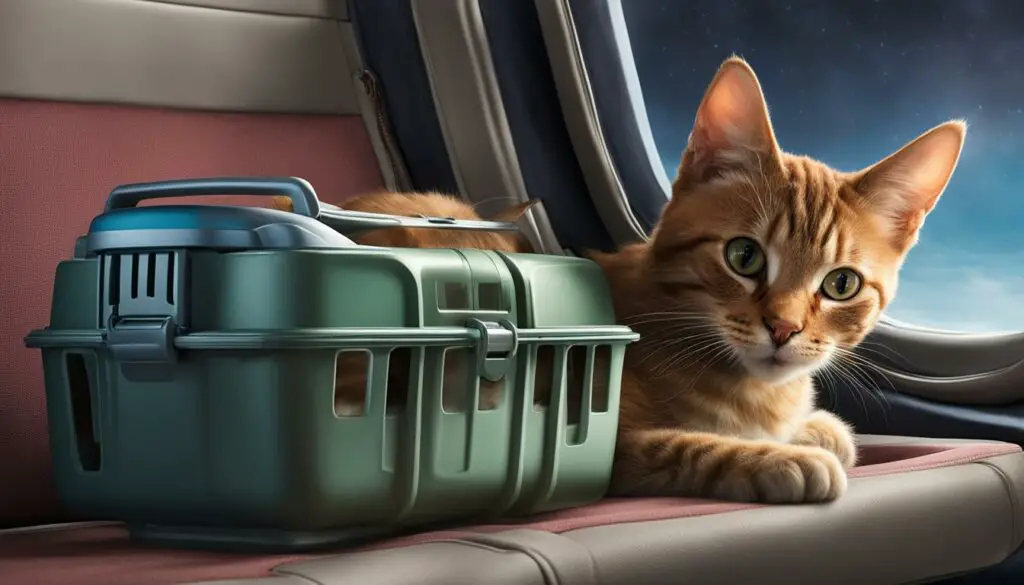
Flying with Cats in Cabin: Packing Paperwork and Supplies
When it comes to flying with cats in the cabin, being prepared with the right paperwork and supplies can make all the difference in ensuring a smooth and stress-free journey. Here are some essential items you should pack:
Paperwork
- Veterinarian Health Certificate: This document proves that your cat is healthy and fit for travel. Make sure to check with your airline for any specific requirements or forms that need to be filled out.
- Vaccination Records: Carry a copy of your cat’s up-to-date vaccination records, including rabies vaccination, as some airlines may require this information.
- Additional Documentation: Depending on your destination, there may be additional forms or permits required. Research the entry requirements of your destination country or state well in advance.
Travel Supplies
- Carrier: Choose a carrier that meets the airline’s regulations and provides comfort and security for your cat throughout the journey. Ensure the carrier has proper ventilation and is large enough for your cat to stand, turn around, and lie down comfortably.
- Food and Water: Pack enough food for the duration of your trip, as well as extra in case of delays. Collapsible food and water bowls are convenient for feeding your cat during the journey.
- Leash and Harness: Even though your cat will be in their carrier during the flight, it’s always a good idea to have a leash and harness handy for any necessary outings, such as security checks.
- Comfort Items: Bring a familiar blanket or toy to provide a sense of comfort and familiarity for your cat during the journey.
- Waste Bags and Cleaning Supplies: Accidents can happen, so be prepared with waste bags, paper towels, and pet-safe cleaning products to clean up any messes.
By packing the necessary paperwork and supplies, you can ensure a stress-free and comfortable journey for both you and your feline companion.
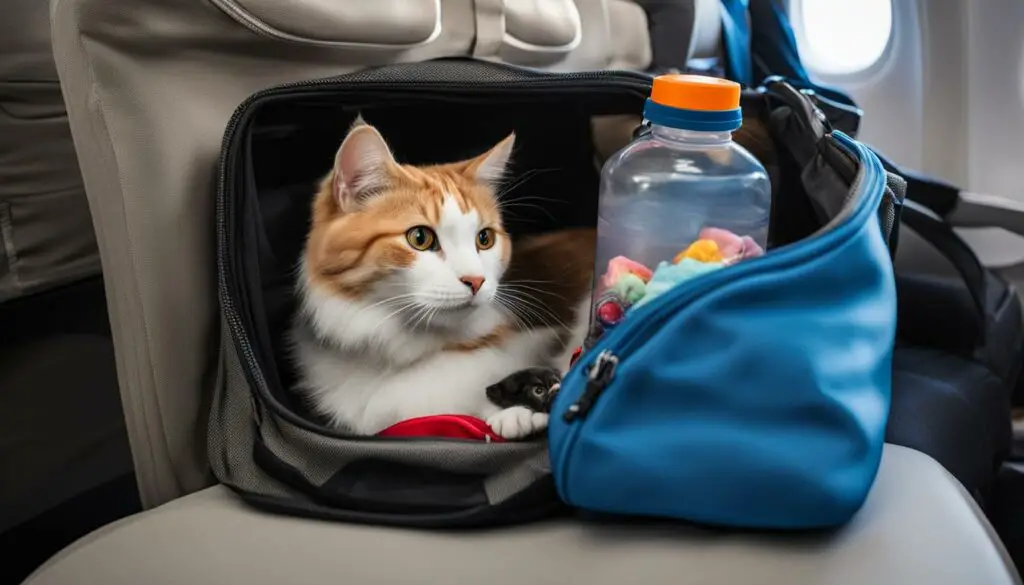
| Item | Description |
|---|---|
| Veterinarian Health Certificate | A document proving your cat’s health and fitness for travel. Check with your airline for specific requirements. |
| Vaccination Records | Up-to-date vaccination records, including rabies vaccination, which may be required by some airlines. |
| Additional Documentation | Research and carry any additional forms or permits required by your destination country or state. |
| Carrier | Choose a carrier that meets airline regulations and provides comfort and security for your cat during the journey. |
| Food and Water | Pack enough food for the trip, including extra in case of delays. Use collapsible bowls for convenience. |
| Leash and Harness | Have a leash and harness ready for any necessary outings, such as security checks. |
| Comfort Items | Bring a familiar blanket or toy to provide comfort and familiarity for your cat during the journey. |
| Waste Bags and Cleaning Supplies | Be prepared with waste bags, paper towels, and pet-safe cleaning products for any accidents or messes. |
Flying with Cats in Cabin: Recognizing Signs of Distress
When flying with cats in the cabin, it’s crucial to be able to recognize signs of distress in your feline friend. Cats are sensitive creatures, and the unfamiliar environment of an airplane can cause anxiety and stress. By understanding the signs of distress, you can address your cat’s needs and ensure their well-being throughout the journey.
Here are some common signs of distress in cats during travel:
- Crying or meowing excessively
- Shivering or trembling
- Vomiting or retching
- Excessive licking or grooming
- Fatigue or lethargy
- Pacing or restlessness
- Excessive yawning
- Discharge from the eyes or nose
- Avoiding eye contact or a glazed-over look
If your cat displays any of these signs, it’s important to provide comfort and reassurance. Speak softly to your cat, offer treats if they are comfortable taking them, and create a calm and soothing environment within the carrier. Remember, each cat is unique, and their distress signals may vary. Pay close attention to your cat’s behavior and consult with your veterinarian if you have any concerns about their well-being.
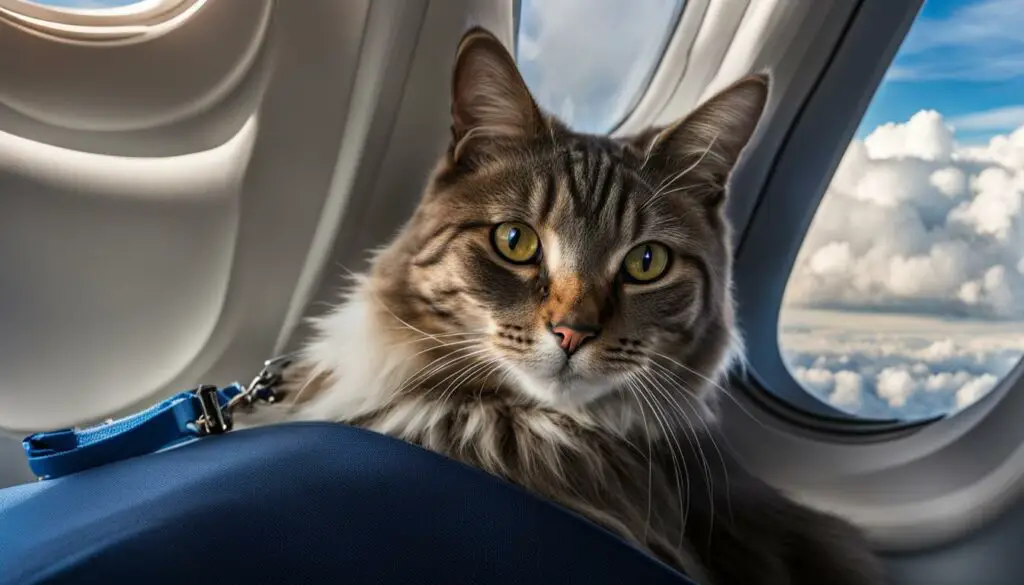
Creating a Calming Environment for Your Cat
To help reduce stress and minimize distress signs in your cat during air travel, here are a few tips:
- Use familiar bedding or a blanket with your scent to provide a sense of comfort.
- Play soothing music or use a pheromone spray designed to calm cats.
- Keep the carrier in a quiet area away from loud noises and sudden movements.
- Avoid opening the carrier during the flight unless necessary.
- Follow the airline’s regulations and guidelines for in-cabin pet travel to ensure your cat’s safety.
Remember, your cat’s well-being should always be your top priority when flying with them in the cabin. By being attentive to their signs of distress and creating a calm environment, you can help ensure a smoother and more comfortable journey for your feline companion.
Flying with Cats in Cabin: Reducing Stress with Exercise
When it comes to flying with cats in the cabin, finding ways to reduce their stress and anxiety is essential for a smooth journey. One effective method is to exhaust your cat before the flight through exercise. Engaging your cat in play and physical activity can help tire them out, making them calmer and more relaxed during the journey.
Providing interactive toys and play sessions can stimulate your cat’s natural instincts and help release extra energy. Activities such as chasing a feather wand, batting at a toy mouse, or playing with a laser pointer can keep your cat physically and mentally stimulated. Remember to always use toys that are safe and appropriate for your cat’s size and age.
An exhausted cat is more likely to sleep and remain calm throughout the flight. This can greatly reduce their anxiety and stress levels, making the journey more enjoyable for both of you. Additionally, exercise can help prevent restlessness and excessive meowing during the flight, ensuring a more peaceful experience for everyone onboard.
It’s important to note that not all cats are equally energetic or responsive to exercise. Some may require more playtime and physical activity, while others may be content with shorter sessions. Observe your cat’s behavior and energy levels to determine what exercise routine works best for them. Consulting with your veterinarian can also provide valuable insights into your cat’s exercise needs and preferences.
By engaging your cat in exercise before the flight, you can help minimize stress and ensure a more comfortable journey for your feline companion. Take the time to play and bond with your cat, knowing that their well-being and happiness are the top priority. Remember, a tired cat is a happy cat, and a happy cat makes for a stress-free flight.
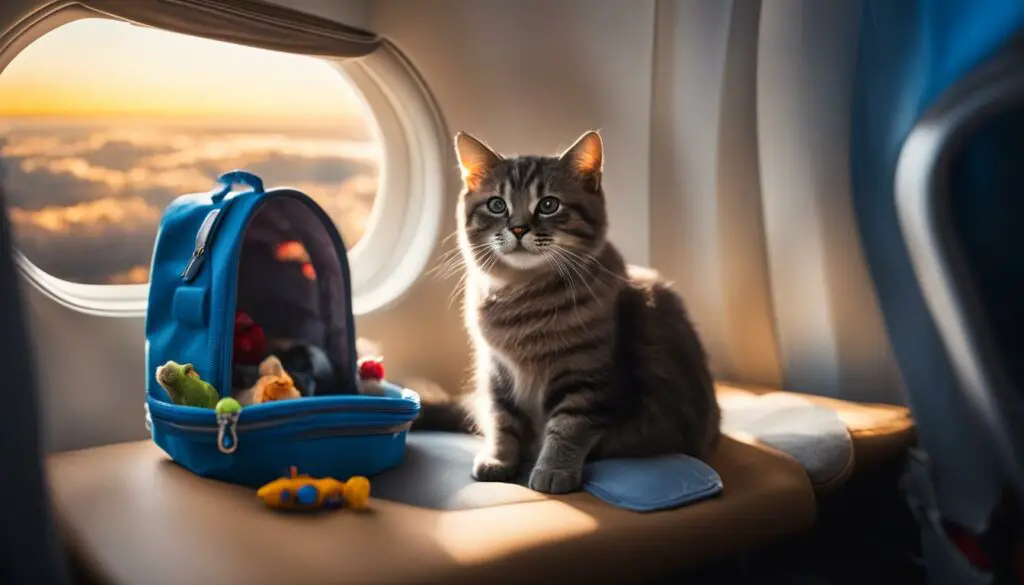
Flying with Cats in Cabin Tips: Booking a Direct Flight
When it comes to flying with cats in the cabin, one of the best tips I can offer is to book a direct flight whenever possible. Choosing a direct flight minimizes the stress and potential complications that can arise from layovers and transfers. It also reduces the total travel time for both you and your feline companion, ensuring a smoother and more comfortable journey.
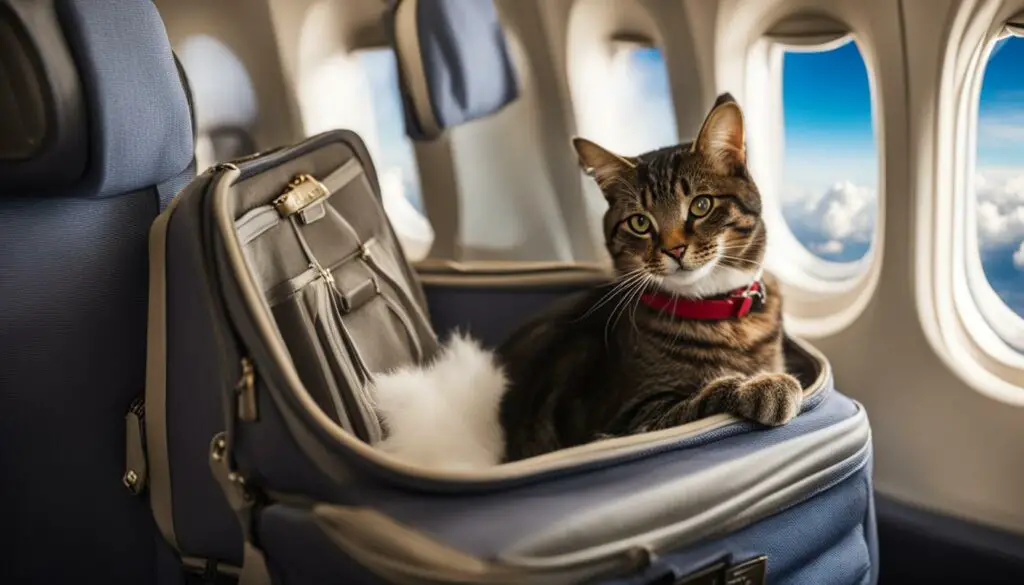
Another helpful tip is to consider flying on weekdays when airports tend to be less crowded. This can help create a calmer environment for both you and your cat, reducing the chances of unnecessary stress. Additionally, it’s important to be mindful of extreme temperatures. During the summer, choose morning or evening flights to avoid the heat, while in winter, opt for midday flights to prevent exposure to colder temperatures.
By booking a direct flight and being strategic with your travel choices, you can make the experience of flying with your cat in the cabin more enjoyable and less stressful for both of you.
Table: Benefits of Booking a Direct Flight for Flying with Cats in Cabin
| Benefits | Description |
|---|---|
| Reduced stress | Avoiding layovers and transfers minimizes the chances of delays, lost luggage, and missed connections, providing a smoother travel experience. |
| Less travel time | Direct flights offer a shorter total travel time, reducing the amount of time your cat spends in the carrier and allowing for a quicker arrival at your destination. |
| Calmer environment | Weekday flights tend to be less crowded, providing a more peaceful and relaxed atmosphere that can help keep your cat calm during the journey. |
| Temperature control | Choosing the right time of day to fly can help avoid extreme temperatures, ensuring your cat’s comfort and well-being throughout the trip. |
Booking a direct flight is just one of the many travel tips to consider when flying with cats in the cabin. By following this advice and implementing other helpful strategies, you can ensure a stress-free and enjoyable journey for both you and your feline companion.
Flying with Cats in Cabin: Leash Training and Airport Procedures
Leash training is an important aspect of flying with cats in the cabin. While cats may not typically wear harnesses and walk on leashes, it is necessary for airport security and customs procedures. By leash training your cat beforehand, you ensure their safety and comfort during these necessary processes.
To start leash training, introduce your cat to wearing a harness at home. Allow them to get used to the sensation and ensure it fits properly. Gradually increase their comfort by attaching a leash and letting them explore in a familiar environment. Reward them with treats and praise for positive behavior, reinforcing the association between the harness and pleasant experiences.
When at the airport, it is important to follow the specific procedures outlined by the airline. Typically, you will need to remove your cat from their carrier during security checks. Having your cat on a leash provides a secure way to guide them through these processes. Always remain calm and patient, providing reassurance and treats when necessary.
Leash Training Your Cat: Step-by-Step Guide
- Introduce your cat to wearing a harness at home.
- Gradually attach a leash and let them explore in a familiar environment.
- Reward positive behavior with treats and praise.
- Follow airline procedures at the airport, keeping your cat on a leash during security checks.
- Remain calm and patient, providing reassurance and treats when necessary.

| Common Airline Leash Requirements | Restrictions |
|---|---|
| Leash Length | Most airlines require a leash length of 6 feet or less. |
| Leash Material | Check with your airline for any restrictions on leash material, as some may have specific requirements. |
| Secure Attachment | The leash should be securely attached to the cat’s harness to prevent escape. |
Ensuring your cat is comfortable with leash training and familiar with airport procedures is essential for a smooth journey. By following these tips, you can navigate through security checks and customs with ease, creating a stress-free travel experience for both you and your feline companion.
Flying with Cats in Cabin: Giving Your Cat Treats
When flying with cats in the cabin, providing positive reinforcement through treats can help keep your feline friend calm and comfortable during the journey. Treats serve as a reward for good behavior and can help create a positive association with the travel experience. Here are some tips on giving your cat treats while flying:
- Choose cat-friendly treats: Opt for treats that are specifically designed for cats and are safe for travel. Look for treats that are easy to carry, non-messy, and won’t cause any digestive issues for your cat.
- Offer treats during check-in: Before boarding the plane, offer your cat treats during the check-in process. This can help distract them from any potential stress and make them more comfortable in their carrier.
- Provide treats during the flight: Once on board, continue to offer treats to your cat intermittently throughout the flight. This can help keep them occupied and provide positive reinforcement for their calm behavior.
- Use treats to reward calm behavior: If your cat remains calm and relaxed during the flight, reward them with treats. This will reinforce their good behavior and help them associate flying with positive experiences.
Remember to be mindful of overfeeding and the potential for motion sickness. It’s important to give treats in moderation to avoid any digestive issues during the flight. Additionally, consult with your veterinarian before the flight to ensure that the treats you plan to give are suitable for your cat’s dietary needs.
By incorporating treats into your in-flight routine, you can create a more positive and enjoyable experience for your cat when flying in the cabin. Offering treats not only helps keep your cat calm, but also strengthens the bond between you and your feline companion throughout the journey.
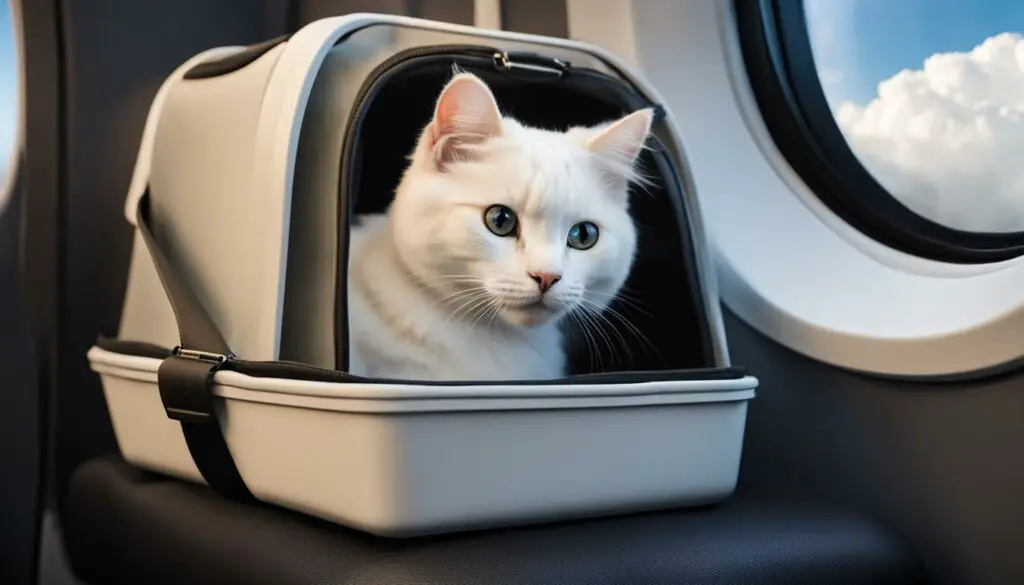
Table: Overview of Cat-Friendly Treats for In-Cabin Flying
| Treat Brand | Treat Type | Key Features |
|---|---|---|
| Brand A | Dry Treats | Crunchy texture, easy to carry |
| Brand B | Soft Treats | Chewy consistency, non-messy |
| Brand C | Freeze-Dried Treats | Lightweight, can be easily broken into small pieces |
Keeping Your Cat Close at All Times
When flying with cats in the cabin, it is crucial to ensure that your furry friend remains close to you throughout the journey. Most airlines have strict regulations regarding in-cabin pet travel, and it is essential to follow these guidelines to ensure the safety and well-being of your cat.
First and foremost, make sure that your cat’s carrier is securely fastened under the seat in front of you. This position keeps your cat within reach and provides them with a sense of security. It is important to note that opening the carrier during the flight is generally not allowed, so it is best to keep your cat inside and avoid any potential mishaps or escape attempts.
During the flight, periodically check on your cat’s well-being to ensure they are comfortable. Offer them treats to provide positive reinforcement and reassurance. However, be mindful of overfeeding and the potential for motion sickness. It is also a good idea to carry extra supplies such as pads, paper towels, and waste bags in case of any emergencies or accidents that may occur.
Remember, your cat’s safety and comfort should be the top priority when flying with them in the cabin. By keeping your cat close at all times and adhering to in-cabin regulations, you can help ensure a smooth and stress-free journey for both you and your beloved feline companion.
| Key Points | Benefits |
|---|---|
| Keep your cat’s carrier securely positioned under the seat | Ensures your cat remains within reach and provides a sense of security |
| Avoid opening the carrier during the flight | Prevents potential mishaps or escape attempts |
| Check on your cat periodically | Ensures their comfort and well-being |
| Offer treats for positive reinforcement | Provides reassurance and creates a positive association with the journey |
| Carry necessary supplies for emergencies or accidents | Be prepared for any unexpected situations |
Tips for Flying with Cats in Cabin [On the Flight]
Once the flight begins, there are a few important tips to keep in mind to ensure the comfort and well-being of your cat. First and foremost, periodically check on your cat throughout the flight to ensure they are calm and comfortable. Avoid opening the carrier during the flight, as it may cause unnecessary stress for your feline companion.
Offering treats can be a great way to provide positive reinforcement and help keep your cat calm during the journey. Offer treats during the check-in process at the airport and periodically throughout the flight when your cat displays calm behavior. However, be mindful of overfeeding and the potential for motion sickness.
Creating a calm and positive environment is essential for your cat’s well-being during the flight. Maintain a calm demeanor yourself and speak to your cat in a soothing tone. The familiar scent of their carrier and the presence of their favorite blanket or toy can also provide comfort and a sense of security.

In case of any potential emergencies or accidents during the flight, it’s always a good idea to be prepared. Carry extra supplies such as pads, paper towels, and waste bags to handle any unexpected situations. By being attentive and prepared, you can ensure a smoother and more comfortable journey for both you and your furry friend.
Conclusion
In conclusion, flying with cats in the cabin can be a stress-free and enjoyable experience when you are well-prepared. By following these travel tips and tricks, you can ensure the comfort and well-being of your furry friend throughout the journey.
Remember to consult with your veterinarian to ensure your cat is healthy enough to travel and obtain any necessary health certificates. Select a cat carrier that meets airline regulations and acclimate your cat to spending time in it before the flight. Familiarize yourself with the signs of distress in cats and be prepared with all the necessary paperwork and supplies.
During the flight, keep your cat close to you in their carrier and provide reassurance as needed. Follow in-flight regulations and maintain a calm environment. By taking these precautions, you can make flying with cats in the cabin a stress-free and enjoyable experience for both you and your furry friend.
FAQ
Is it safe for cats to fly in the cabin?
Yes, it is safe for cats to fly in the cabin as long as proper preparation and care are taken. Consult with your veterinarian and follow airline regulations to ensure a safe and comfortable journey for your cat.
What should I do before booking a flight with my cat?
Before booking a flight, make sure your cat is healthy and fit to travel. Consult with your veterinarian and ensure all necessary paperwork and supplies are prepared. Familiarize yourself with airline regulations and choose the right cat carrier that meets their requirements.
How can I get my cat used to their carrier?
Gradually acclimate your cat to their carrier by introducing them to it in a positive and comfortable manner. Use treats, toys, and familiar bedding to create a positive association. Practice runs and short outings in the carrier can also help your cat become more comfortable.
What are the signs of distress in cats during travel?
Signs of distress in cats may include crying, shivering, vomiting, fatigue, excessive licking, excessive yawning, discharge from eyes, pacing, and a glazed-over look. Monitor your cat’s behavior closely and be prepared to provide comfort and reassurance if needed.
Can I feed my cat before the flight?
To minimize the chances of your cat needing to use the bathroom during the flight and reduce the risk of motion sickness, limit their access to food and water before the flight. Follow the airline’s recommendations on when to feed your cat before departure.
What should I pack for my cat’s travel?
Make sure to pack your cat’s food, treats, collapsible food and water bowls, leash, waste bags, and a familiar blanket or toy. Also, gather all the necessary paperwork including health certificates and vaccination records required by the airline.
Can my cat stay with me during the flight?
Most airlines require that cats remain in their carriers throughout the flight when flying in the cabin. Ensure that your cat’s carrier is secure and comfortably positioned under the seat in front of you. Follow the airline’s regulations and guidelines for in-cabin pet travel.
How can I keep my cat calm during the flight?
Engage your cat in play and exercise before the flight to help tire them out and reduce stress. Offer treats during the airport check-in process and onboard the plane to provide positive reinforcement. Keep your cat’s carrier close to you and maintain a calm and positive environment.
Can I take my cat out of the carrier during the flight?
It is recommended to keep your cat in their carrier throughout the flight for their safety. However, be prepared for any potential emergencies or accidents by carrying extra supplies such as pads, paper towels, and waste bags.
Are there any specific regulations for flying with cats in the cabin?
Each airline has different regulations regarding flying with cats in the cabin. It is important to familiarize yourself with the specific requirements of the airline you are flying with to ensure a smooth and hassle-free journey.
Source Links
- https://vcahospitals.com/know-your-pet/flying-with-your-cat
- https://www.petsthattravel.com/flying-with-cats-in-cabin/
- https://yourcatbackpack.com/blogs/cat-backpack-tips-and-advice/the-ultimate-guide-to-flying-with-your-cat

